MariaDB is an open source database system that stores and manages structured data. It is often chosen for its reliability, speed, and compatibility with MySQL. Many websites, applications, and services use MariaDB to handle data securely and efficiently. Monitoring MariaDB provides real-time visibility into database activities, helping to detect suspicious behavior, prevent unauthorized access, and strengthen overall security posture.
This blog post shows how to monitor a MariaDB server using Wazuh. We use the MariaDB audit plugin to generate logs of database activity, such as login attempts and SQL queries, and configure Wazuh to collect and analyse these logs for security monitoring.
Infrastructure
We use the following infrastructure to demonstrate MariaDB server monitoring.
- A pre-built, ready-to-use Wazuh OVA 4.12.0, which includes the Wazuh central components (Wazuh server, Wazuh indexer, and Wazuh dashboard). Follow this guide to download and set up the Wazuh virtual machine.
- A Fedora server 42 endpoint with:
- The Wazuh agent 4.12.0 installed and enrolled in the Wazuh server.
- MariaDB server 10.11 installed following these instructions.
Configuration
In this section, we set up the MariaDB audit plugin on the Fedora server. Next, we create decoders and rules on the Wazuh server to detect relevant database activity.
Fedora server endpoint
Perform the following steps to configure the MariaDB audit plugin. This plugin helps to log and monitor database activity.
- Append the following settings to the
/etc/my.cnfconfiguration file:
[server] server_audit_logging=ON [mariadb] plugin_load_add=server_audit [mysqld] server_audit_output_type=SYSLOG server_audit_events=connect,query,table,query_ddl,query_dml server_audit_syslog_info=mariadb server_audit_syslog_ident=mariadb-server_auditing
Where:
server_audit_logging: Enables the MariaDB audit plugin at server startup.plugin_load_add: Loads the audit plugin.server_audit_output_type: Defines the format in which audit logs are sent.server_audit_events: Defines the types of events to log.server_audit_syslog_info: Adds a custom info tag to the log entries.server_audit_syslog_ident: Defines the identifier used in syslog logs. This will be used as theprogram_namewhen creating the Wazuh decoder.
- Restart the MariaDB server to apply the changes:
# systemctl restart mariadb.service
Note
With server_audit_output_type=SYSLOG on Fedora endpoints, MariaDB audit logs are sent to journald. Wazuh collects journald logs by default via the Wazuh Logcollector module, so no extra configuration is needed on the Wazuh agent.
Wazuh server
Perform the following steps to create custom decoders and rules on the Wazuh server.
- Create a custom decoder file
mariadb_decoders.xmlin the/var/ossec/etc/decoders/directory and insert the following:
<decoder name="mariadatabase-decoder">
<program_name>mariadb-server_auditing</program_name>
</decoder>
<decoder name="mariadatabase-syslog">
<parent>mariadatabase-decoder</parent>
<regex type="pcre2">^(\S+)\s+(\S+),([^,]*),([^,]*),(\d+),(\d+),([^,]*),([^,]*),(.*),(\d*)$</regex>
<order>mariadb.info,mariadb.serverhost,mariadb.username,mariadb.userhost,mariadb.connectionid,mariadb.queryid,mariadb.operation,mariadb.database,mariadb.object,mariadb.retcode</order>
</decoder>
The custom Wazuh decoder above was created based on the official MariaDB Audit Plugin log format documentation. This ensures that the decoder properly interprets the structure and fields of the audit logs generated by MariaDB.
- Create a custom rule file
mariadb_rules.xmlin the/var/ossec/etc/rules/directory and insert the following rules:
<group name="mariadatabase,">
<rule id="100700" level="0">
<decoded_as>mariadatabase-decoder</decoded_as>
<description>"MariaDB audit -"</description>
</rule>
<!-- successful account manipulation -->
<rule id="100701" level="7">
<if_sid>100700</if_sid>
<field name="mariadb.object" type="pcre2">(?i)GRANT|REVOKE|CREATE USER|DROP USER|RENAME USER</field>
<field name="mariadb.retcode" type="pcre2">^0$</field>
<description>"MariaDB audit -" Successful account manipulation: $(mariadb.object)</description>
<mitre>
<id>T1078</id>
</mitre>
</rule>
<!-- successful DROP/TRUNCATE/DELETE execution -->
<rule id="100702" level="10">
<if_sid>100700</if_sid>
<field name="mariadb.object" type="pcre2">(?i)DROP TABLE|DROP DATABASE|TRUNCATE|DELETE</field>
<field name="mariadb.retcode" type="pcre2">^0$</field>
<description>"MariaDB audit -" Successful deletion: $(mariadb.object)</description>
<mitre>
<id>T1485</id>
</mitre>
</rule>
<!-- successful modification-->
<rule id="100703" level="7">
<if_sid>100700</if_sid>
<field name="mariadb.object" type="pcre2">(?i)ALTER|UPDATE</field>
<field name="mariadb.retcode" type="pcre2">^0$</field>
<description>"MariaDB audit -" Successful schema/data modification: $(mariadb.object)</description>
<mitre>
<id>T1565.001</id>
</mitre>
</rule>
<!-- Unauthorized access to MariaDB server -->
<rule id="100704" level="5">
<if_sid>100700</if_sid>
<field name="mariadb.operation" type="pcre2">FAILED_CONNECT</field>
<description>"MariaDB audit -" Authentication failed: $(mariadb.username)@$(mariadb.userhost)</description>
<group>authentication_failures,</group>
<mitre>
<id>T1110.001</id>
</mitre>
</rule>
<!-- Possible brute force attack -->
<rule id="100705" level="7" frequency="5" timeframe="30">
<if_matched_sid>100704</if_matched_sid>
<field name="mariadb.operation" type="pcre2">FAILED_CONNECT</field>
<same_field>mariadb.userhost</same_field>
<description>"MariaDB audit -" Possible brute force attack from $(mariadb.username)@$(mariadb.userhost)</description>
<group>authentication_failures,</group>
<mitre>
<id>T1110</id>
</mitre>
</rule>
<!-- Data definition operation-->
<rule id="100706" level="5">
<if_sid>100700</if_sid>
<field name="mariadb.object" type="pcre2">(?i)RENAME</field>
<field name="mariadb.retcode" type="pcre2">^0$</field>
<description>"MariaDB audit -" Successful data definition operation: $(mariadb.object)</description>
<mitre>
<id>T1036</id>
</mitre>
</rule>
<rule id="100707" level="5">
<if_sid>100700</if_sid>
<field name="mariadb.object" type="pcre2">(?i)CREATE</field>
<field name="mariadb.retcode" type="pcre2">^0$</field>
<description>"MariaDB audit -" Successful data definition operation: $(mariadb.object)</description>
<mitre>
<id>T1565.001</id>
</mitre>
</rule>
<!-- Data manipulation operation-->
<rule id="100708" level="5">
<if_sid>100700</if_sid>
<field name="mariadb.object" type="pcre2">(?i)INSERT|MERGE</field>
<field name="mariadb.retcode" type="pcre2">^0$</field>
<description>"MariaDB audit -" Successful data manipulation operation: $(mariadb.object)</description>
<mitre>
<id>T1565.001</id>
</mitre>
</rule>
<!-- successful disconnection from MariaDB server -->
<rule id="100709" level="3">
<if_sid>100700</if_sid>
<field name="mariadb.operation">DISCONNECT</field>
<description>"MariaDB audit -" User session closed: $(mariadb.username)@$(mariadb.userhost)</description>
</rule>
<!-- successful authentication to MariaDB server -->
<rule id="100710" level="3">
<if_sid>100700</if_sid>
<field name="mariadb.operation" type="pcre2">^CONNECT</field>
<field name="mariadb.retcode" type="pcre2">^0$</field>
<description>"MariaDB audit -" Successful authentication: $(mariadb.username)@$(mariadb.userhost)</description>
</rule>
<!-- Data query-->
<rule id="100711" level="3">
<if_sid>100700</if_sid>
<field name="mariadb.object" type="pcre2">(?i)SELECT|SHOW|DESCRIBE|USE|EXPLAIN</field>
<field name="mariadb.retcode" type="pcre2">^0$</field>
<description>"MariaDB audit -" Successful data query: $(mariadb.object)</description>
<mitre>
<id>T1082</id>
</mitre>
</rule>
<!-- Plugin operation -->
<rule id="100712" level="7">
<if_sid>100700</if_sid>
<field name="mariadb.object" type="pcre2">(?i)INSTALL|UNINSTALL|PLUGIN</field>
<field name="mariadb.retcode" type="pcre2">^0$</field>
<description>"MariaDB audit -" Plugin operation detected: $(mariadb.object)</description>
</rule>
<!-- Execution Error -->
<rule id="100713" level="3">
<if_sid>100700</if_sid>
<field name="mariadb.retcode" type="pcre2">(?!0\b)\d+</field>
<description>"MariaDB audit -" An operation returned error $(mariadb.retcode): $(mariadb.object)</description>
</rule>
<!-- All other successful operations -->
<rule id="100714" level="3">
<if_sid>100700</if_sid>
<field name="mariadb.retcode" type="pcre2">^0$</field>
<description>"MariaDB audit -" Successful operation: $(mariadb.object)</description>
</rule>
</group>
Where:
- Rule ID
100700is a base rule triggered for all MariaDB audit logs parsed by the custom decoder. - Rule ID
100701is triggered when a user account is created, removed, or modified usingCREATE USER,DROP USER,RENAME USER,GRANT, orREVOKEcommands. - Rule ID
100702is triggered when aDROP TABLE,DROP DATABASE,TRUNCATE, orDELETEcommand is successfully executed on a database, indicating data or table removal. - Rule ID
100703is triggered when a schema or data modification uses theALTERorUPDATEstatements. - Rule ID
100704is triggered when a login attempt to the MariaDB server fails. - Rule ID
100705is triggered when five failed login attempts occur within 30 seconds, indicating a possible brute-force attack. - Rule ID
100706is triggered when aRENAMEcommand is used to alter database objects. - Rule ID
100707is triggered when aCREATEcommand is used to define database objects. - Rule ID
100708is triggered when data is added or merged usingINSERTorMERGEcommands. - Rule ID
100709is triggered when a user session is closed. - Rule ID
100710is triggered when a user successfully authenticates to the MariaDB server. - Rule ID
100711is triggered when users perform read-only queries such asSELECT,SHOW,DESCRIBE,USE, orEXPLAIN. - Rule ID
100712is triggered when aPLUGINoperation, such asINSTALLorUNINSTALLis successfully executed on the MariaDB server, indicating plugin-level changes. - Rule ID
100713is triggered when an SQL command returns an error (non-zero return code). - Rule ID
100714is triggered for any successful MariaDB operation not covered by more specific rules.
- Restart the Wazuh manager to apply the changes:
# systemctl restart wazuh-manager
Testing
We perform the following actions on the Fedora server to trigger alerts:
- Authentication events
- Data definition operations
- Data manipulation operations
- Data destruction operations
- Data access and query events
- Account and privilege operations
- Failed operations
Authentication events
- Run the following command to simulate a brute force attack. This triggers the alerts
100704,100705, and100709:
$ for i in {1..5}; do mariadb -u attacker -pwrongpasword; done
- Log in to the MariaDB CLI using the default MariaDB root account. This triggers the alert
100710:
$ mariadb -u root -p
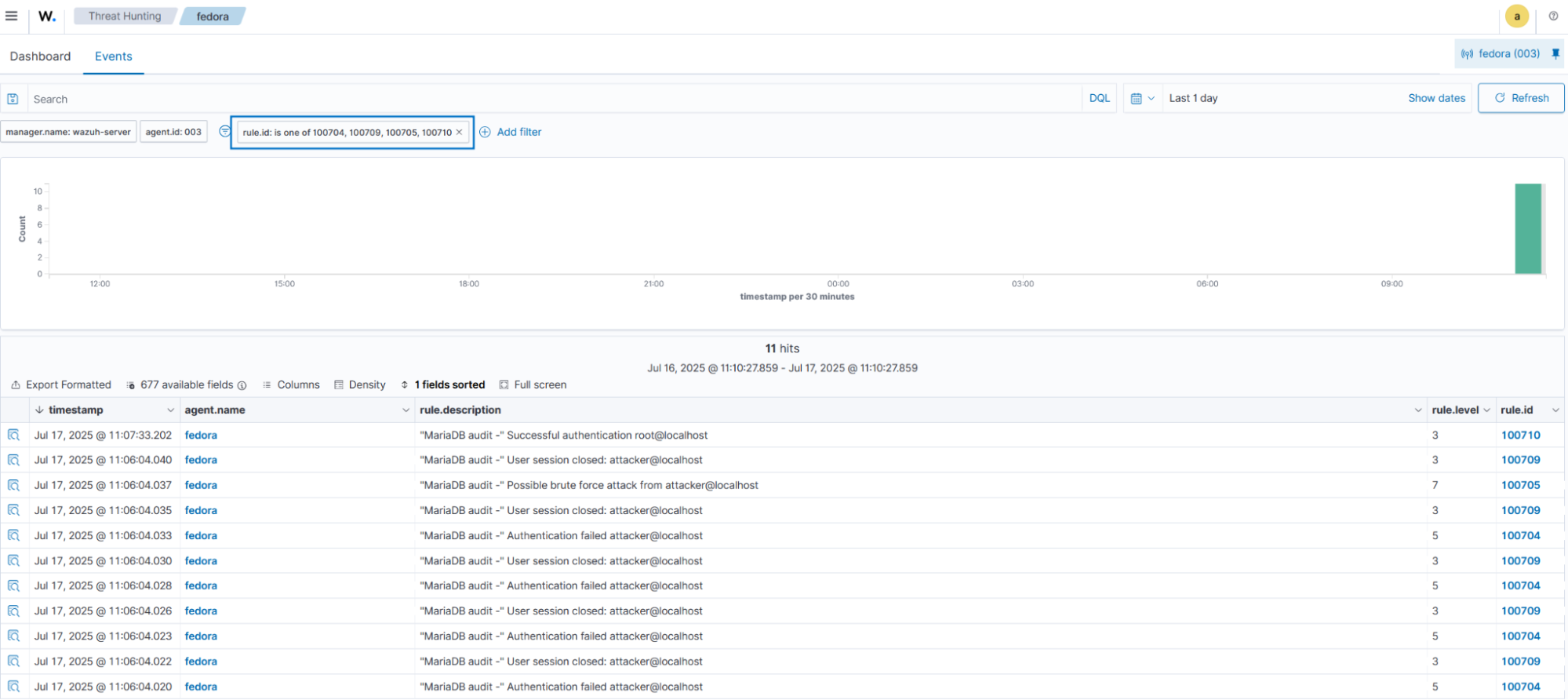
Note
For all the SQL commands in the sections below, remain logged in as the root user.
Data definition operations
- Create the database
demo_dbby running the command below. This triggers the alert100707:
CREATE DATABASE demo_db;
- Switch to the
demo_dbdatabase. This triggers the alert100711:
USE demo_db;
- Create a
userstable. This triggers the alert100707:
CREATE TABLE users (id INT, name VARCHAR(100));
- Rename the table from
userstoclients. This triggers the alert100706:
RENAME TABLE users TO clients;
- Alter the
clientstable. This triggers the alert100703:
ALTER TABLE clients ADD email VARCHAR(255);
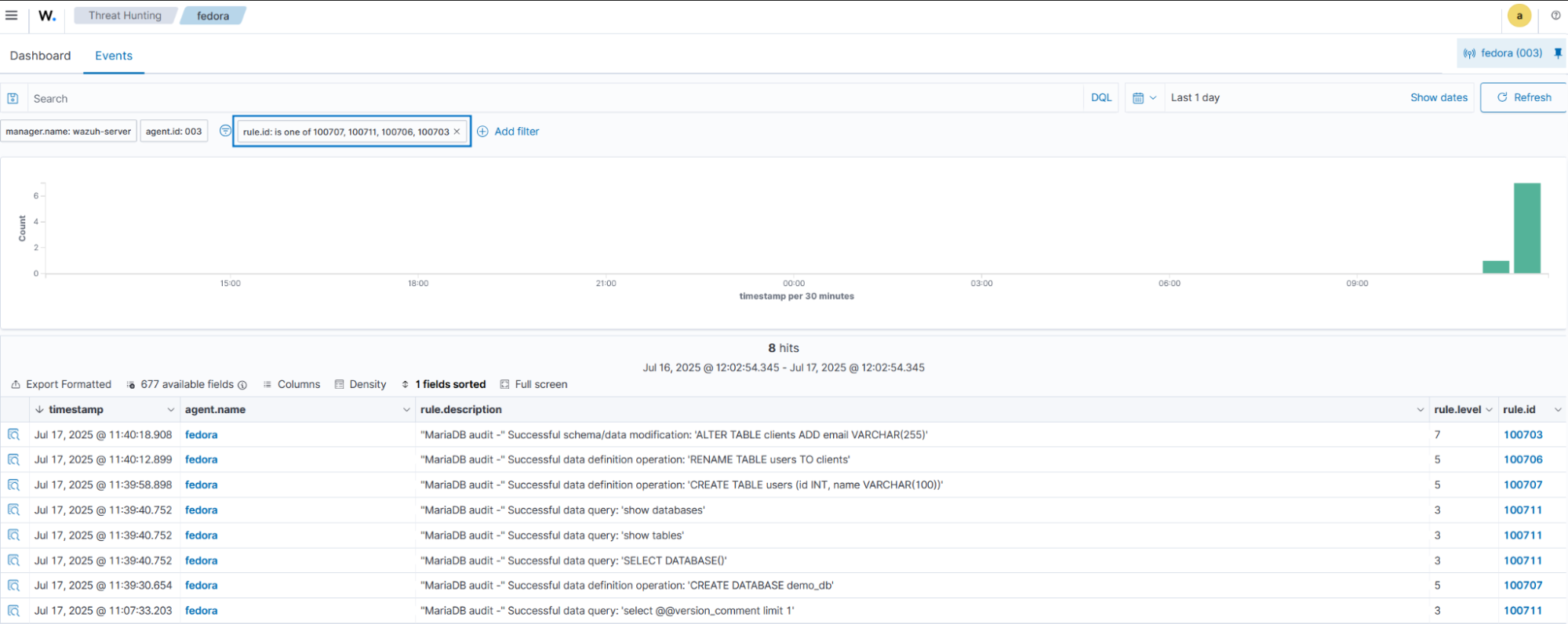
Data manipulation operations
- Insert data in the
clientstable. This triggers the alert100708:
INSERT INTO clients (id, name, email) VALUES (1, 'John Doe', 'john@example.com'); INSERT INTO clients (id, name, email) VALUES (2, 'Jane Doe', 'jane@example.com');
- Update a record in the
clientstable. This triggers the alert100703:
UPDATE clients SET email = 'john.doe@example.com' WHERE id = 1;

Data destruction operations
- Delete an entry in the
clientstable. This triggers the alert100702:
DELETE FROM clients WHERE id = 1;
- Drop the
clientstable. This triggers the alert100702:
DROP TABLE clients;

Data access and query events
- Show existing databases. This triggers the alert
100711:
SHOW DATABASES;

Account and privilege operations
- Create a user named
testerthat can connect only fromlocalhost, with a defined password. This triggers the alert10071:
CREATE USER 'tester'@'localhost' IDENTIFIED BY 'testpass';
- Grant full privileges to the user
testeron thedemo_dbdatabase. This triggers the alert10071:
GRANT ALL PRIVILEGES ON demo_db.* TO 'tester'@'localhost';
- Revoke all privileges from the user
testeron thedemo_dbdatabase. This triggers the alert10071:
REVOKE ALL PRIVILEGES ON demo_db.* FROM 'tester'@'localhost';
- Drop the user
tester. This triggers the alert10071:
DROP USER 'tester'@'localhost';
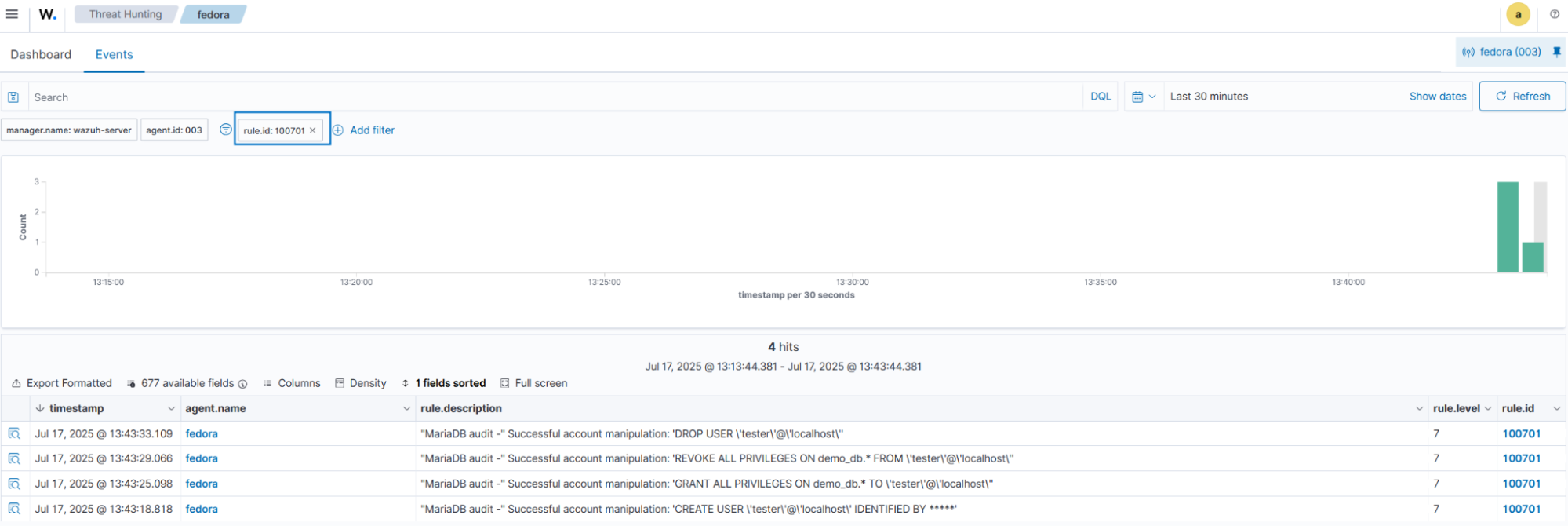
Failed operations
- Run the command below to trigger an unexpected event. This triggers the alert
100713:
DROP TABLE non_existent_table;

Visualizing alerts on the Wazuh dashboard
Perform the following steps to visualize the alerts generated on the Wazuh dashboard:
- Navigate to Threat intelligence > Threat Hunting > Events on the Wazuh dashboard.
- In the search bar, type
rule.groups:mariadatabase, and click Update.
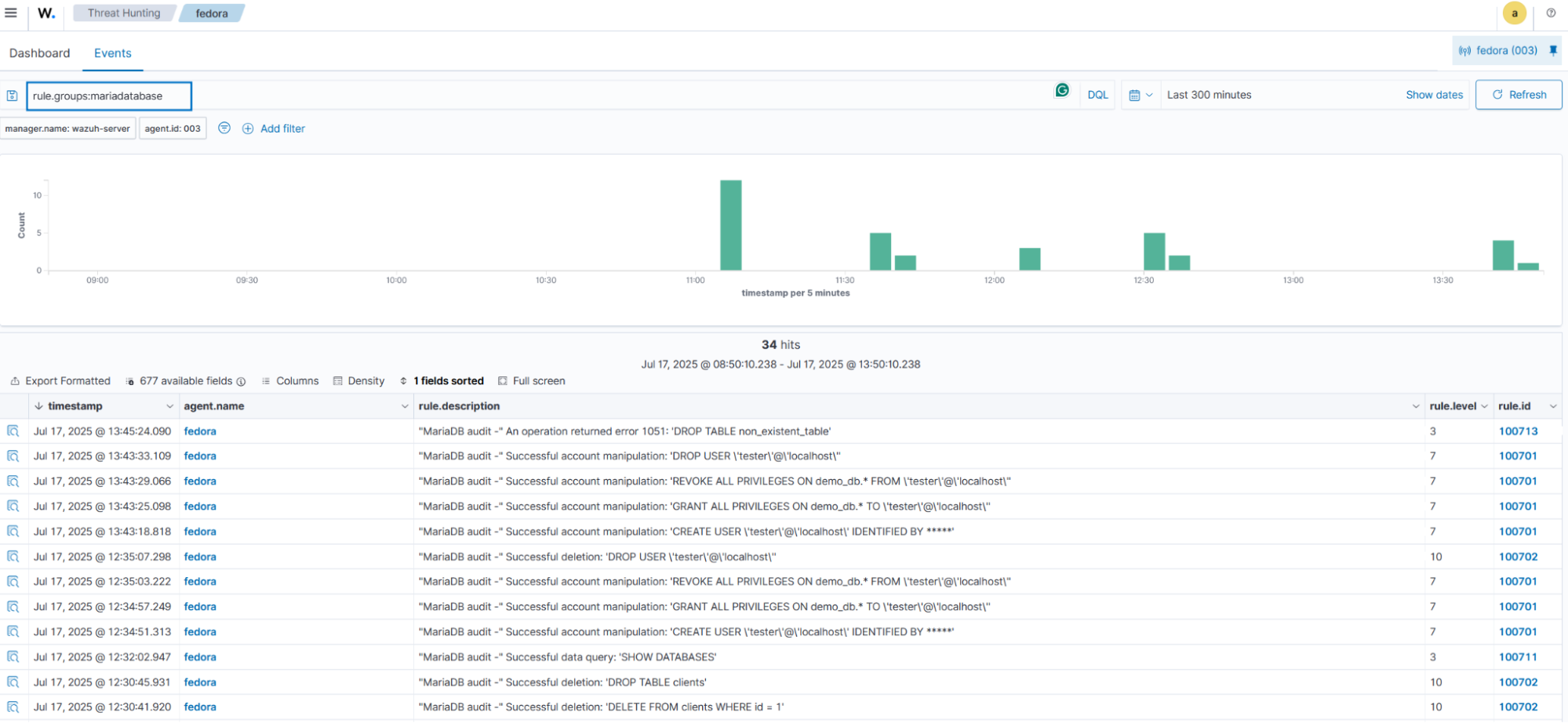
- Click Inspect document details on an alert to have a detailed view.
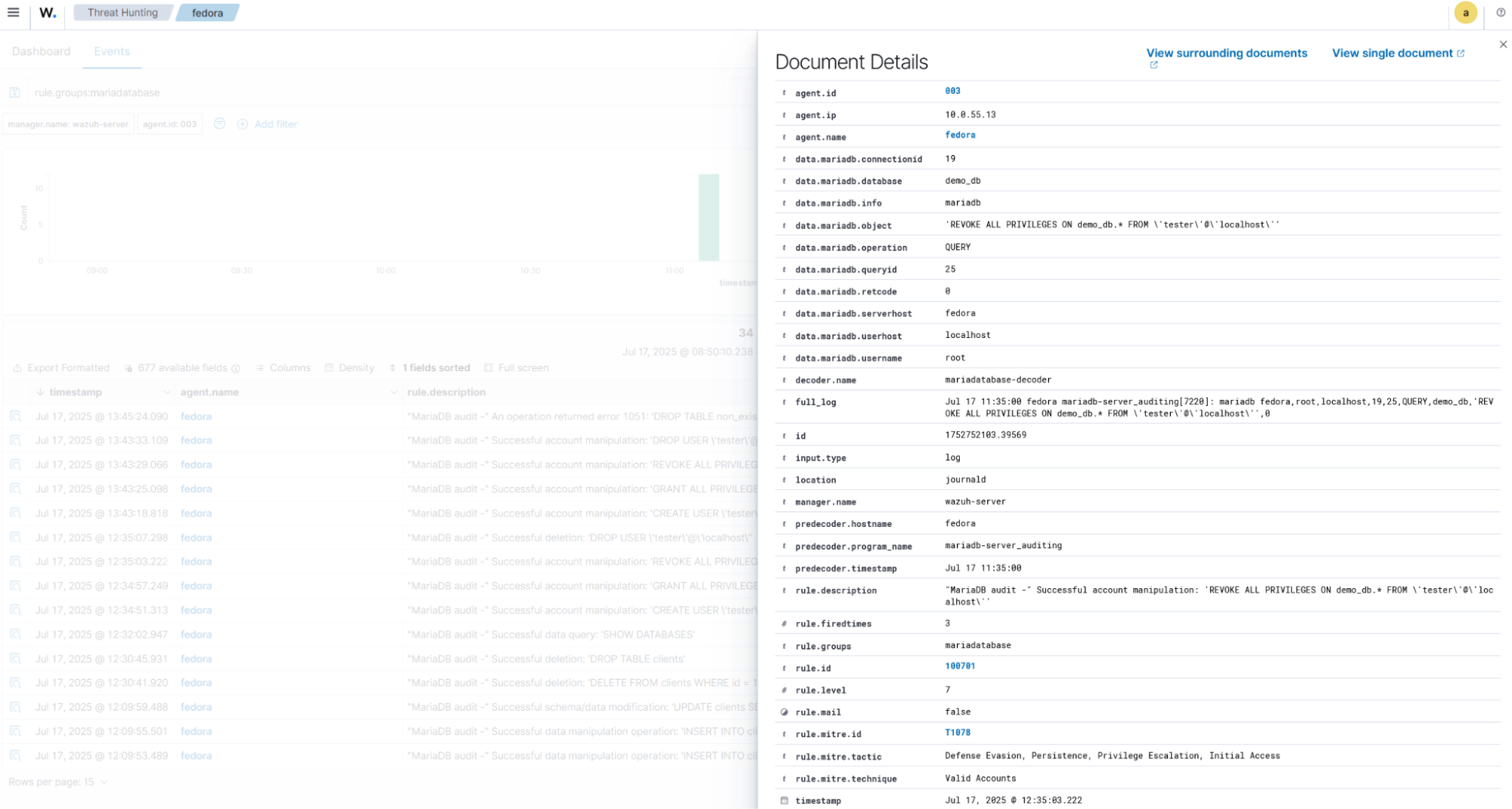
Conclusion
This blog post demonstrates how Wazuh can monitor activities performed on a MariaDB server. By integrating MariaDB auditing with Wazuh, organizations gain visibility into database operations, enabling them to detect suspicious behavior and enhance their overall security posture.
Wazuh is a free and open source security solution designed for threat detection, incident response, and compliance management. Wazuh continues to provide new integrations and capabilities, and has an active and supportive community.
To learn more, explore our documentation and blog posts.
